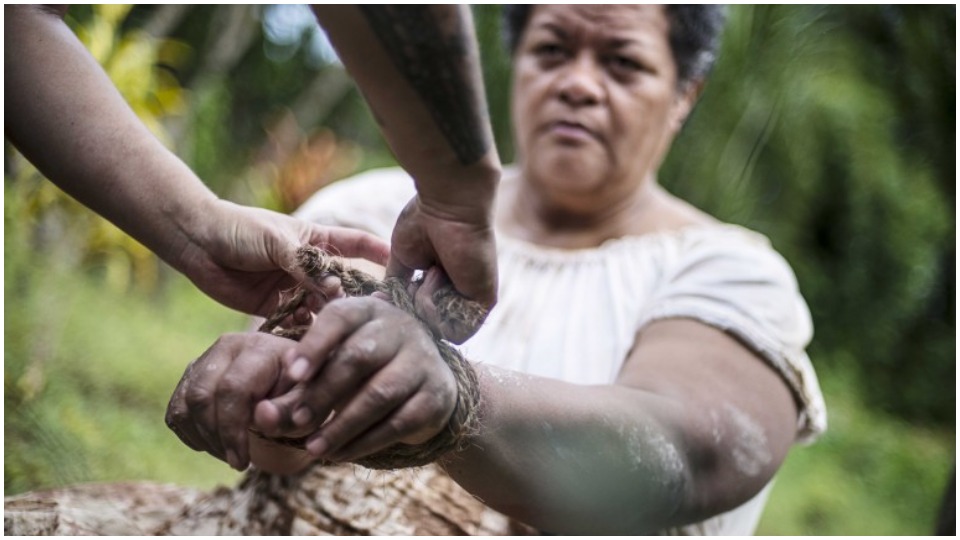
The first installment of reviews from this year’s 36th annual Los Angeles Asian Pacific Film Festival can be found here. Further shorts, documentaries, animation, and features by and about the Pacific Islands’ Indigenous peoples are available online through Oct. 31.
‘Liliu’: Samoa’s decolonization struggle
When I lived in Tafitoala, Upolu, the village’s high chief, Ale Sola (I believe that is the correct spelling), used to tell me about his exploits in the Mau, which was an Indigenous resistance movement against the New Zealand colonizers who ruled Samoa in his youth. The independence movement’s slogan was “Samoa Mo Samoa,” which translates as “Samoa for the Samoans.” In 1962 Samoa became the first Pacific Island to experience decolonization.
I always thought Ale’s stories would make for a good movie. Now New Zealand-born Samoan writer/director Jeremiah Tauamiti has taken a stab at telling this tale onscreen in Liliu. Shot on location in Samoa, and set in 1920 in what is called in a title “The New Zealand Territory of Western Samoa,” the plot consists of soldiers bringing defendants to a colonial kangaroo court beneath a thatch roof in a fale (hut) in the Polynesian countryside. There a bewigged paternalistic palagi (Caucasian) magistrate (Peter Hayden) passes judgment over Samoans being tried for crimes against the colonizers and the colonial state. The alleged infractions include trespassing and non-payment of taxes imposed by New Zealand which, as part of the British Commonwealth, is still ruled by a monarch thousands of miles away in London.
The judge is aided by a court interpreter, Solo (Vito Vito, who acted in the 2016 feature Three Wise Cousins and 2019’s Take Home Pay, both comedies made by Stallone Vaiaoga-Ioasa). I don’t want to reveal details but His (dis)Honor, personifying the N.Z. colonial state, surprisingly encounters defiance that embodies the struggle against foreign domination.
From a film history perspective, it’s interesting to compare Liliu with a classic that was actually lensed on location in Samoa in the 1920s, celebrated filmmaker Robert Flaherty’s Moana of the South Seas. The film was hailed as a great work of art and landmark in the development of the documentary, although it is arguably more akin to a docudrama (a debate that is beyond the scope of this review). In Moana, Savaii is depicted as a paradise, and there is no mention of the Mau movement for independence from N.Z. nor of the influenza epidemic which thanks to the bungling, thoughtless, wild incompetent N.Z. authorities unleashed with tragic consequences on Western Samoa.
In her confrontation with the racist judge, Nua (Ana Tuisila) seems to allude to the flu epidemic of circa 1918 when she mentions that her husband was “killed.” Shot in a straightforward style, Liliu is only 17 minutes long, but hopefully, Taumiti will have the opportunity to create a feature-length film that dramatizes the decolonization cause. In 2019 Taumiti directed a feature-length documentary about an idiot brainwashed by the missionaries’ religion at Tonga, For My Father’s Kingdom. Hopefully, soon this talented filmmaker will get a crack at making a full-length feature.
The illustrated islanders

Colonialism sought to “civilize” savages, which included not only banning many Indigenous cultural practices but even Native peoples’ presentation of self in everyday life. As part of this acculturation, the Polynesian art form of traditional tattooing was prohibited. At least two films in this year’s LAAPFF deal with the tattoo which, by the way, played a central role in Flaherty’s 1926 film, wherein the titular Moana undergoes the age-old Samoan knee-to-navel tattoo process. Directed by Heretu Tetahiotupa and Christophe Cordier, the 55-minute Patutiki: The Guardians of the Marquesan Tattoo is about practitioners of this inky art of the Marquesas, the archipelago located 700 miles north of Tahiti in French-occupied Polynesia, where tattooing may have reached its Oceanic apotheosis.
FilmFreeway quotes Heretu Tetahiotupa, who was born in the Marquesas (I believe at Nuku Hiva), as explaining: “People’s attraction to Marquesan tattoo is mostly aesthetic, but there’s much more to patutiki than its distinctive designs. We wanted people to become aware of the spiritual dimension and how each motif was a key to understanding how the ancients perceived the world. People are drawn to these symbols without knowing why. The Marquesans see patutiki as a magical manifestation of their predecessors’ past. For more than a thousand years, master tattoo artists and shamans connected to the spirit of our ancestors, re-created rituals transferring mana every time they practiced their art.”
Directed by Mick Andrews and David Atkinson, Tā Moko—Behind the Tattooed Face takes place in a marae (Maori meeting place) where Polynesians Bernard and Sapphire separately go to undergo the laborious, painful process of getting facial tattoos in order to reconnect with their ancestral traditions. It is a communal undertaking filled with onlookers. Bernard’s inky designs cover his whole face, while Sapphire literally takes it on her chin. Interestingly, the tattooist doesn’t use a shark’s tooth, squid’s ink, adze or other traditional implements, but quite contemporary equipment to render his illustrations on the islanders in this 12-minute, conventionally made short shot on location in Aotearoa/N.Z.
Oceanic astronaut

With Kalewa, independent Hawaii filmmaker Mitchel Viernes is reminiscent of Jules Verne, as he takes the South Seas Cinema genre into outer space. Kainoa Kalewa (Michael Hake) is a Hawaiian astronaut in this futuristic film that I suspect rather cleverly uses the Big Island’s volcanic, smoky location to great effect, evoking an otherworldly ambiance. The notion that Hawaiians could be astronauts is totally plausible: Their ancient forebears were among the planet’s greatest explorers, sailing across the vast reaches of the Pacific, and Kealakekua, Hawaii’s Ellison Onizuka, flew aboard NASA’s space shuttle missions. For the akamai (in the know) viewer, Kainoa’s name may be a wink and a nod toward Hawaii’s greatest living navigator, Nainoa Thompson of the fabled voyaging canoe Hōkūle’a.
In addition to sci-fi genre conventions, writer/director Viernes injects a psychological dimension into his story. Kainoa’s mission to a galaxy far, far away is also a metaphor for the distance between him and his father David, movingly played by veteran Hawaiian actor and entertainer Kimo Kahoana. Like Kimo, other cast members of Kalewa, Danielle Zalopony and Jason Quinn appear in more films screened this year at LAAPFF, notably the excellent feature Waikiki. Viernes’s 17-minute Kalewa is clever on multiple levels and, like some of the Festival’s other shorts, leaves the hungry viewer with an appetite to see more. Hopefully, Viernes will get the opportunity to shoot a full-length feature and conjure up his own mysterious islands.
Many of the Pacific Islander shorts can be seen through Oct. 31 at LAAPFF’s Pacific Cinewaves pay-what-you-can link.

MOST POPULAR TODAY

High Court essentially bans demonstrations, freedom of assembly in Deep South

Zionist organizations leading campaign to stop ceasefire resolutions in D.C. area

U.S. imperialism’s ‘ironclad’ support for Israel increases fascist danger at home

UN warns that Israel is still blocking humanitarian aid to Gaza







Comments